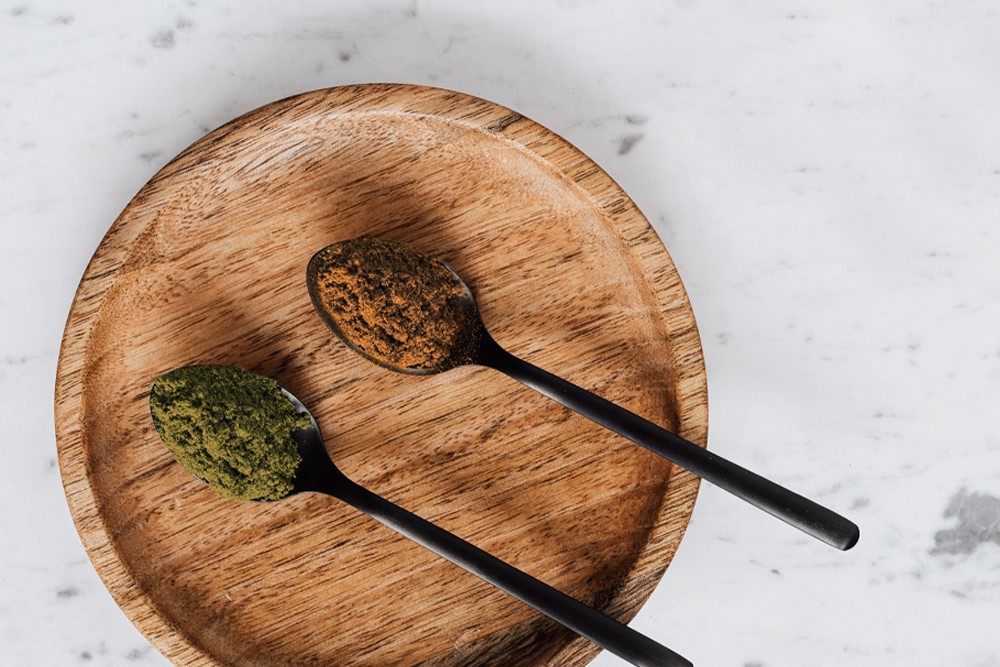
It seems that a new botanical supplement enters the market every month. At Kratom Spot, we are dedicated to educating you on the wealth of botanicals out there. Why? Because we believe in bettering the world, and botanicals like Mitragyna speciosa – better known as kratom – can help.
Today, we’re going to examine a traditional botanical that seems to be entering wellness markets en masse: kanna. Scientifically known as Sceletium tortuosum, this supplement is commonly available as both kanna extract and kanna powder.
Has kanna been evaluated by the FDA for safety and efficacy? How do kanna products stand up to kratom strains? And what will we learn when comparing kanna vs. kratom head-to-head? Let’s find out!
Origins of Kanna vs. Kratom
As you may already know, kratom strains derive from the Mitragyna speciosa tree, native to Southeast Asia. Mitragyna speciosa leaves are dried and crushed into kratom powder. Alternatively, the alkaloids from kratom leaves can be extracted to craft kratom extracts.
In this light, kanna is not dissimilar to kratom. Hailing from South Africa, the Sceletium tortuosum is a succulent that sprouts small, sunflower-colored flowers. The Sceletium tortuosum flowers – much like Mitragyna speciosa leaves – are dried into kanna powder. In addition, the natural alkaloids of these flowers can be extracted to create kanna extract.
When discussing the origins of botanical medicines, it can be difficult to pinpoint an exact time in history. Southeast Asian populations have consumed kratom as a traditional medicine for generations. As agricultural industries began to flourish in the region, farmers chewed wild kratom leaves for an energy boost as well.
Unlike early kratom stories, there exist written accounts for kanna powder use. Jan van Riebeeck was a Dutch colonist working for the infamous East India Trading Company. He is known as the founder of Cape Town, South Africa. Furthermore, in 1662, he wrote about local hunter-gatherers fermenting and chewing Sceletium tortuosum plants. In his account, van Riebeeck noted that kanna offered mood-elevating properties, among other health benefits.
The Effects of Kanna vs. Kratom
Now that we understand where both kanna and kratom come from, let’s examine what these botanicals actually do. For starters, we know that kratom offers health and wellness-boosting properties. Because scientific studies have yet to be evaluated by the FDA, we cannot openly advertise the benefits of kratom strains.
Kanna extracts and other kanna products are said to offer similar benefits to your health and wellness. While these benefits have also not yet been evaluated by the FDA, they include:
- Elevated Mood
- Decreased Anxiety
- Reduced Tension
- Stimulant Properties
- Euphoria
Kanna is known to be non-toxic to humans in small doses, much like kratom. Dissimilarly, however, kanna extract is known as a sedative in high doses, potentially offering much riskier side effects. Please use caution when dosing kanna or any other botanical supplement you are unfamiliar with.
How Do You Take Kanna?
We talked briefly about the differences between kanna products like kanna powder and kanna extract. But how do you take these products, and is the process similar to how you ingest kratom strains?
For starters, let’s remember the different ways to take kratom:
- Mixing kratom powder or extract into water, juice, or another beverage.
- Making kratom tea.
- Ingesting kratom with food.
- Taking pre-dosed kratom capsules.
- Kratom’s toss & wash method.
- Using oblate discs to take kratom.
As we know, kanna is readily available as both kanna powder and kanna extract. This means that we can use many of the same kratom ingestion methods we already know! However, non-scientific user reports have suggested that kanna can be smoked. Kratom should not be smoked under any circumstances.
Kanna vs. Kratom: Are They Legal?
As devout followers of kratom news may already know: kratom is legal in the United States. However, some areas have banned kratom within their borders until the FDA comes to a consensus on the supplement.
Kanna is a bit more obscure. Many people haven’t heard about the botanical, including the FDA. Because of this, there does not appear to be any anti-kanna legislation worldwide. As with any supplement, we’ll have to wait and see if kanna powder becomes more popular. When that happens, we’ll probably start to see kanna-focused legislation.
Kanna vs. Kratom: Which One Should You Take?
Now that we’ve investigated the similarities and differences between kanna vs. kratom, let’s review what we’ve learned!
- Kratom comes from Southeast Asia, while kanna derives from South Africa.
- Kanna and kratom are both used as traditional medicines, but written accounts give us a rough timeline of kanna use.
- Both kratom and kanna can be crafted into powders and extracts.
- Both botanicals offer similar benefits to your health and wellness.
- Neither botanical has been evaluated by the FDA.
- Kanna and kratom are both legal in the United States. However, some specific areas (like the city of San Diego, for example) have banned kratom. There does not appear to exist any anti-kanna legislation worldwide, probably due to its obscurity.
With all this in mind, it’s easy to see how kratom and kanna are similar. But which one should you take for your health and wellness?
Keep in mind that kanna powder is considered an obscure supplement. As such, it can be difficult to find authentic kanna on the market. Furthermore, it’s even more difficult to find third-party lab tests that prove what you’re taking is actually kanna.
Because of this, we do not recommend taking kanna products. While both kanna and kratom have yet to be evaluated by the FDA, kratom has been on the market much longer. At Kratom Spot, all of our products come with third-party lab testing and an efficacy guarantee. Stick to what you know!

